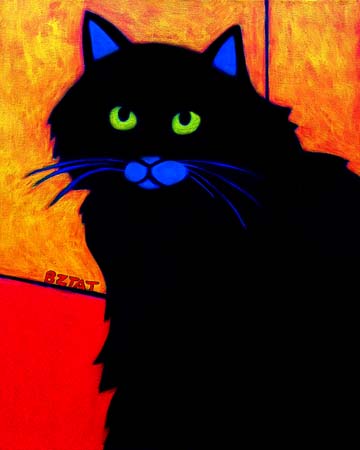
As a teaching artist, I visit a number of preschool classes every week. One of the many learning objectives layered into my art lessons is helping students identify patterns. Each child’s moment of recognition of a pattern is often filled with excitement. Discovery of patterns is thrilling when it is a new concept.
We still have strong emotional responses as our minds grow and become more adept at identifying patterns. The response is deep. Sometimes it is relaxing and sometimes it is exhilarating depending on the design, textures and color intensity.
Patterns can spark a range of emotional reactions while also enhancing intellectual capacities.
I enjoy adding patterns to my compositions when I paint portraits of pets. Many pets have intriguing patterns in their coats, and combining those with patterned backgrounds can be a great visual challenge. Often, when I see a patterned rug or cloth of some sort in the photos submitted for a portrait, I find a way to include it in the composition.
In the above portrait of Tommy and Ollie (Thomas and Oliver if we want to be formal), I included the patterns from an authentic Persian rug on which these two felines loved to lounge. Their tabby cat stripes are offset by the rich designs and colors in the rug. I believe that this makes the portrait a more dynamic artwork than if I had focused simply on capturing the cats’ likenesses.

A portrait calls for more than making images that look like the subjects. A portrait calls for an interesting design and composition that inspires emotion on many levels. The emotion is not sentimentality, although some sentiment is acknowledged. The color and patterns take the painting to a different level, making it an artwork that can be appreciated even if you have no actual connection to the subjects.
In this portrait of Claude, I could not resist including the intricately patterned blanket on which this beautiful cat reclined in the submitted photos. Including the pattern made the portrait much more difficult and added considerable time to the process, but I think it was worth it.
(Claude’s portrait was recently featured on Hauspanther, where you can see the original photos from which the painting was designed.)

The patterns in Francie’s portrait to the right led to a more abstract design for the the overall composition. I was intrigued with the cool colors of her coat contrasting with the warmer colors in the background. I also enjoyed playing with the haphazard quality of the patterns in her fur and the energetic quality of the background designs.
I do not include patterns in all of my custom pet portraits. Sometimes a simple background makes a strong composition, and sometimes I include scenery or other background choices. I find that the ones with patterns are often my favorites, however. I look forward to creating more of them in the future.
The important takeaway here is that painting a pet’s portrait, for me, is more than painting what the animal looks like. I am challenged to create an experience for the viewer that excels in the visual elements as well as meets a patron’s desire for art resembling his or her pet. Achieving an accurate likeness of the pet is important. The relationship between human and beast is best expressed, though, when the rigors of color, texture and design are applied to the painting. My hope is that I meet that challenge each time that I combine patterns, pets and portraits.
Interested in commissioning a portrait of your pet? Learn more here.
Life is an Adventure!
BZTAT








